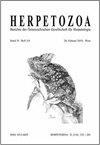Melanism in the grass snake Natrix natrix (Linnaeus, 1758) from the Danube Delta Biosphere Reserve, Romania
IF 0.9
4区 生物学
Q3 ZOOLOGY
引用次数: 0
Abstract
Animal colouration has a significant ecological role in defence, reproduction, and thermoregulation. In the case of melanism, it is a complex topic. Besides potential disadvantages such as higher risk of predation, melanistic ectotherms may have certain physiological advantages such as more efficient thermoregulation in colder climates and thus, reduced basking time. The common grass snake (Natrix natrix) is a widespread species throughout Europe and Asia. It exhibits a wide range of colour polymorphisms, from olive to dark grey, even albinistic and melanistic. Between 2016 and 2021, we conducted fieldwork in the Danube Delta Biosphere Reserve (DDBR) with the aim to document the geographic range of melanistic grass snakes. We categorised the melanistic expressions of N. natrix individuals as melanotic, completely melanistic, and partially melanistic. Melanistic snakes were encountered in all six localities visited, suggesting that the occurrence of melanistic grass snakes in the DDBR is geographically widespread. We observed both juveniles (n=2) and adults (n=11) with melanism, suggesting that individuals are born melanistic. However, the proportion of melanistic individuals in the general population of N. natrix from the DDBR is unknown. Only at Histria locality we studied the proportion of melanism in the grass snake population and 6.3% of the snakes caught were melanistic. Body size comparisons are not statistically significant because of the low sample size. The N. natrix melanistic morph’s geographical distribution in the DDBR is most likely due to an interaction of climate and habitats, which offer a thermal advantage in the face of predation pressure.Melanism取自罗马尼亚多瑙河三角洲生物圈保护区的草蛇Natrix (Linnaeus, 1758)
Animal着色在防御、繁殖和体温调节中具有重要的生态作用。就黑化而言,这是一个复杂的话题。除了潜在的缺点,如更高的被捕食的风险,黑变变温动物可能有某些生理上的优势,如在较冷的气候下更有效的体温调节,从而减少晒太阳的时间。常见的草蛇(Natrix Natrix)是欧洲和亚洲广泛分布的物种。它表现出广泛的颜色多态性,从橄榄色到深灰色,甚至白化病和黑化。2016年至2021年间,我们在多瑙河三角洲生物圈保护区(DDBR)进行了实地调查,目的是记录黑草蛇的地理范围。我们将N. natrix个体的黑化表达分为黑化、完全黑化和部分黑化。在所有6个地点都发现了黑蛇,这表明黑蛇在DDBR的地理分布广泛。我们观察到幼鱼(n=2)和成年鱼(n=11)都有黑化症,这表明个体天生就有黑化症。然而,来自DDBR的N. natrix一般种群中黑色素个体的比例尚不清楚。仅在史提亚地区,我们研究了黑蛇在草蛇种群中的比例,捕获的蛇中有6.3%是黑蛇。由于样本量小,体型比较没有统计学意义。黑桫椤在DDBR的地理分布很可能是气候和生境相互作用的结果,它们在面对捕食压力时具有热优势。
本文章由计算机程序翻译,如有差异,请以英文原文为准。
求助全文
约1分钟内获得全文
求助全文

 求助内容:
求助内容: 应助结果提醒方式:
应助结果提醒方式:


